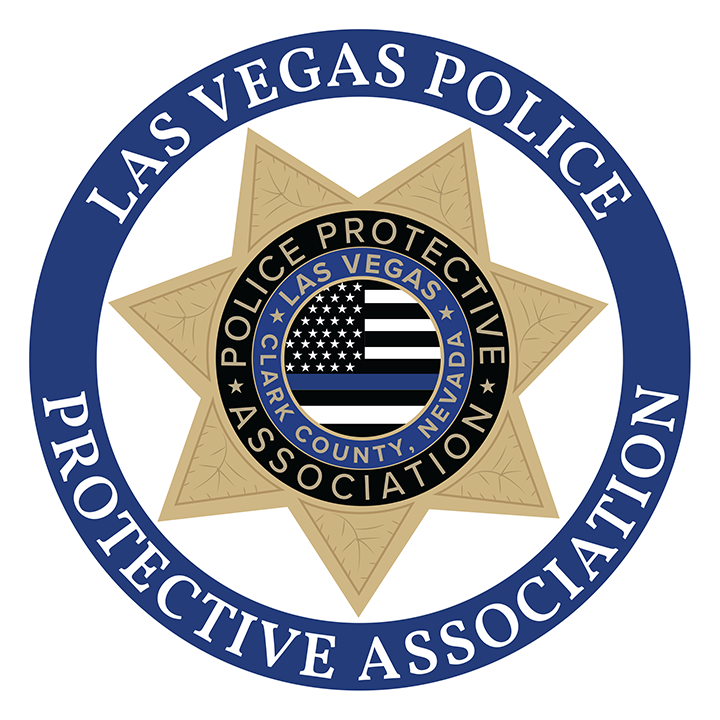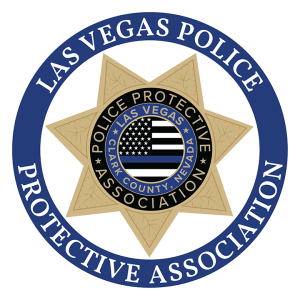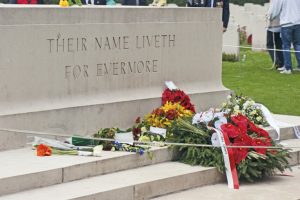 At the time of this publication, our country will be remembering our war heroes, past and present, at home and forward deployed in distant lands, with the observance of Veterans Day. Born in London to a British mother, I was fortunate enough to know and talk with my Uncle George about his military service and his memory of being part of Operation Market Garden, the largest airborne invasion in WWII. This epic battle was depicted in the 1977 movie A Bridge Too Far.
At the time of this publication, our country will be remembering our war heroes, past and present, at home and forward deployed in distant lands, with the observance of Veterans Day. Born in London to a British mother, I was fortunate enough to know and talk with my Uncle George about his military service and his memory of being part of Operation Market Garden, the largest airborne invasion in WWII. This epic battle was depicted in the 1977 movie A Bridge Too Far.
My uncle, George Durant, was born in 1922 and joined the British Army in early 1942. By the summer of 1944, he was serving with the Signals Party at No. 1 Battery Headquarters, 1st Airlanding Light Regiment.
He flew to Arnhem, Netherlands, on Sunday, September 17, 1944, his wood glider landing safely on LZ-N near the village of Wolfheze. After nine days of continuous combat action, he was captured by the Germans, issued POW
No. 91884 and first sent to Stalag XIIA, then IVB and IVC. He was liberated by Russian Allied Forces in May 1945.
My Uncle George writes: “I was a driver/wireless operator. I suppose there were approximately eight to 10 to a battery/troop whose function was to link communication by radio and even hand-laid line telephone (a legacy from WWI) between our OPs [observation posts] and the artillery guns command post, thus providing information and supporting fire to the forward infantry when needed.
“We were mobile, and this long-established and well-trained drill was practiced by the Royal Artillery (RA) Field regiments — though particularly difficult at Arnhem, there being no real ‘front’ and the first lift of 1st Airborne Division stretched all over the place.
“I landed by glider in the first lift on Sunday, 17 September, 1944, about 1:40 p.m. — a very ‘nose-in,’ heavy landing. Up front was my Troop Sergeant Major Reed and two or three others, my jeep, radio, trailer with spare gun ammo, compo rations, TSM’s motorcycle, and riding in the tail with myself were Archie Pitt and Bob Dixon.
“We were at such a steep angle on landing that us three had to jettison the trailer and drop off with it. We then had to hack enough wood fuselage away to extract the personnel, jeep, etc., but this we accomplished, whilst other gliders were homing in and paras [paratroopers] literally dropping on top of us.
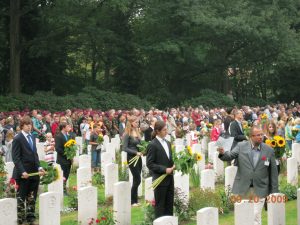 “TSM Reed had damaged both his ankles badly (we thought he’d broken them), so we lashed him onto the jeep and I took his m/c [motorcycle] and we eventually made good progress to our first position, on some sloping ground, dug in a command post and remained there that night to await the arrival of the second lift (which, of course, was badly delayed). Next day was not too active, except around noon we got strafed by German fighter aircraft ME 109s, which at first we had thought to be our own British Spitfires! After two or three passes, they disappeared with no serious damage in our position.
“TSM Reed had damaged both his ankles badly (we thought he’d broken them), so we lashed him onto the jeep and I took his m/c [motorcycle] and we eventually made good progress to our first position, on some sloping ground, dug in a command post and remained there that night to await the arrival of the second lift (which, of course, was badly delayed). Next day was not too active, except around noon we got strafed by German fighter aircraft ME 109s, which at first we had thought to be our own British Spitfires! After two or three passes, they disappeared with no serious damage in our position.
“That night we moved into a new position nearer Arnhem on the edge of some woodland, and from then on, it got hairy indeed. We made several forays and patrols into the outskirts of Arnhem and many to Divisional HQ to try and find some sort of pattern of the front lines, but after mid-week, the battle had degenerated into scores of disjointed sectors, finally squeezed into the famous perimeter around Oosterbeek, NL.
“Against and into this zone, the Germans poured troops, shells and mortars, the latter particularly nasty, as their six-barreled mortar rounds emitted a gut-wrenching, low increasing moan as they were coming in!
“It was on the rim of this area, at dusk, an officer ordered about 18 of us — mixed units — to hold three slit trenches at all costs and to stay there alive or dead until further orders. He told us that there had been a breakthrough and relief forces were coming over the Rhine that night and, repeating his order, he took off into the gloom — we never saw him again, but complied. We’d heard this so many times before, but it might be correct this time! As you well know, you just don’t question an order.
“As darkness fell, an almighty barrage developed and went on for hours and eventually faded into a weird silence before dawn. The five others I was with, which I seem to recall included a sergeant in the Recce Squadron, and myself were elated that we were still in action, but this drained away as it got light and we broke cover to see what the score was — we were totally surrounded by German troops, who had just walked over us.
“We were marched some way down to a road where there were 30 or so other Airborne comrades, and I met Wally Bowtell, another signaler from my section, who had just been taken POW. Then we learned that some of the remnants of the 1st Airborne Division had managed to get back over the Rhine, but at least we carried out our last order to the end.
“Wally and I remained together via various POW camps right through to the end of the war. We met two or three times after the war until he emigrated to Australia, but the greatest reunion was when we raised our glasses in the Centrum Café by Arnhem railway station on 17 September, 1994, exactly 50 years to the day we first landed there.
“It was near here, in some railway sidings, that the Germans herded the British prisoners, who were locked in covered cattle-wagons (70 in a truck) to begin a grim nine-day journey to Limburg, Germany, [Stalag] 12A, which was situated in a sea of constant liquid mud.
“I was selected, together with a mixed bag of Airbornes, for what transpired to be ‘special interrogation’ and taken to an unknown camp. En route, via Cologne, we were almost lynched by civilians reacting to a recent Royal Air Force [RAF] raid.
“A few days in and out of solitary and sick bay and then back to Limburg, then to Mulburg, Stalag IVB. Eager for escape opportunities, I joined a working party, which unfortunately proved to be a coal mine (Bettyschacht IVC) sited in a high-security zone. It entailed a 12-hour shift, six days a week, half a mile underground and on a starvation diet with weather at sub-zero.
“Early in 1945, we were moved to an open-cast mine near Brux, Czechoslovakia, surviving several determined RAF night raids, which pulverized the nearby benzene plant. Sadly, it was during one such raid that we lost three Airborne lads, killed by an exploding ack-ack shell in the roof of the hut.
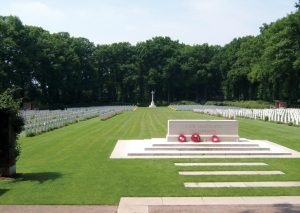 “This camp was overrun by the Russians, who liberated us on 7 May, 1945. We foraged around Brux, but the situation became increasingly hazardous. The Russians took increasingly large numbers of civilians for summary target practice in retaliation for the actions of young SS-styled fanatics who, armed to the teeth, were dedicated to taking pot shots at anything that moved after nightfall.
“This camp was overrun by the Russians, who liberated us on 7 May, 1945. We foraged around Brux, but the situation became increasingly hazardous. The Russians took increasingly large numbers of civilians for summary target practice in retaliation for the actions of young SS-styled fanatics who, armed to the teeth, were dedicated to taking pot shots at anything that moved after nightfall.
“We were eventually evacuated by the Russians to the 3rd U.S. Army (General Patton’s Army) and thence, in stages back to the England.
“After returning from Germany, some leave and rehabilitation training, I requested to return to the Light Regiment, which I did, but it disbanded in late 1945. Twenty of us flew out to Hyderabad, India, as advance party to Eagle Troop, 6th Royal Horse Artillery, the rest of them traveling by sea. They were, by now, using Sherman tanks as OPs and armored self-propelled 25-pounders! We could well have done with those at Arnhem! It was a good regiment, and I stayed with them until demobbed.”
Uncle George Durant died on September 11, 2010, at age 88. His wish was to be cremated and his ashes buried with his “mates” who fought and died in the Battle of Arnhem. In early 2011, his ashes were taken in a casket on a tour around all the principal sites of the European battles. In September 2011, my mom and I traveled to the Arnhem Oosterbeek War Cemetery, more commonly known as the Airborne Cemetery, to inter his ashes. This cemetery was established in 1945, and every year since, the surrounding townspeople celebrate the self-sacrifice these brave men made to help liberate their country by holding a weekend of ceremonies that accumulate in a flower-laying memorial for the 1,750 graves at the Airborne Cemetery. The town’s children file into the manicured grounds and stand in front of the graves. The children have done this each September since 1946. On cue, they lay the flowers on top of the grave markers and then speak the name of the solider and kiss the top of the marker. This is a very emotional and touching remembrance for these fallen and surviving heroes to be honored. It is fitting that the entrance to the Arnhem Oosterbeek War Cemetery displays a solid piece of granite with the words “Their Name Liveth Evermore.”
